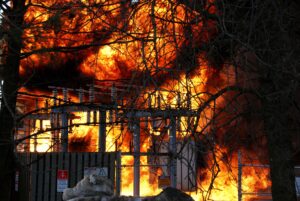Traditionally, electrical shock (from human touch) has been the primary topic of concern rather than arc-flash hazards that result from faults & failures of energized electrical components. For decades, loads of technical information have been published, and many talks have been given to help us understand how to avoid electrical shock and the hazards that cause it. We’re all familiar with the three states of matter: solid, liquid and gas. If you’ve read about modern science or taken modern science classes, there is a fourth state of matter—it’s called plasma.
An arc flash is a plasma—it’s an ionization of the molecules in the air around the electrical equipment. The air around and close to two objects of different potential—a potential high enough to cause an electrical breakdown of the air between them—experiences a short circuit, or an arc. The arc starts out extremely small and invisible to the naked eye. The small arc current that starts to flow is the beginning of ionization and grows to form a visible plasma.




When arc becomes large enough to “flash”, the environment around the electrical equipment can become extremely hazardous for nearby personnel when working on or near the energized electrical equipment. In power systems / power quality engineering, this arc flash is called a fault. In fact, the growing arc surrounds the highest current called the fault current which is the core of the arc. The arc-flash produces large amounts of heat that can burn the skin of the nearby personnel and set clothing & other combustible materials on fire. From the fault location, the arc-flash will emit a flash of light, a loud noise, ionized gases, metal vapors, molten metal droplets, shrapnel, and shock waves with forces large enough to throw personnel back away from the equipment. Arc flashes can cause bodily injury including third-degree burns, permanent eye damage and even death.
Basically, an arc-flash hazard study is an analysis of the arc-flash hazards at a facility or site to determine the appropriate Personal Protection Equipment (PPE) and safe distances at various pieces of electrical equipment inside and around the facility including substations, switchboards, switchgear, power distribution panel boards, branch circuit panels and motor control centers. The Arc-Flash Hazard Analysis takes the short circuit analysis and protective device coordination study another step by determining incident energy levels, required PPE, and boundary distances between humans and energized electrical equipment. This information is printed on a serial-numbered industry-approved label that must be attached to the front of electrical equipment. The information on the label provides the required information enabling the facility owner, plant manager or site electrical engineer to comply with the NFPA/IEEE guidelines that are enforced by OSHA standards and inspectors.
Adherence to arc flash requirements is paramount to power systems and PQ engineers. Expert engineers at PBE are qualified to conduct short-circuit analyses, protective device coordination studies and arc flash studies. Because power systems and PQ engineers must frequently inspect energized electrical equipment for wiring & grounding errors, install PQ monitoring equipment and make other PQ-related measurements, a properly rated arc flash suite (also called PPE) must be worn when within a specified & safe distance of the exposed and energized electrical equipment.
PBE’s power systems / PQ engineering consulting services and service contracts typically contain short-circuit analyses, protective device coordination studies and arc flash studies for new facilities and facilities undergoing equipment upgrades.
Utilities, A&E firms & end users will benefit from having PBE conduct arc flash studies. With the requirement from safety agencies & insurance companies to conduct these studies every five years, PBE can bundle an arc flash study with other PQ services to provide customers with a package meeting all of their needs. Bundling PQ services with an arc flash study will make your plant a much safer work environment that no attorney can argue.
Want to learn more about PQ & keep up with new PQ problems facing customer facilities, plus much more? Subscribe to one of PBE Engineers’ newsletters that’s free!